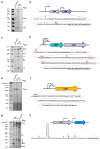Insights into the Stress Response Triggered by Kasugamycin in Escherichia coli
- PMID: 27258317
- PMCID: PMC4929434
- DOI: 10.3390/antibiotics5020019
Insights into the Stress Response Triggered by Kasugamycin in Escherichia coli
Abstract
The bacteriostatic aminoglycoside antibiotic kasugamycin inhibits protein synthesis at an initial step without affecting translation elongation. It binds to the mRNA track of the ribosome and prevents formation of the translation initiation complex on canonical mRNAs. In contrast, translation of leaderless mRNAs continues in the presence of the drug in vivo. Previously, we have shown that kasugamycin treatment in E. coli stimulates the formation of protein-depleted ribosomes that are selective for leaderless mRNAs. Here, we provide evidence that prolonged kasugamycin treatment leads to selective synthesis of specific proteins. Our studies indicate that leaderless and short-leadered mRNAs are generated by different molecular mechanisms including alternative transcription and RNA processing. Moreover, we provide evidence for ribosome heterogeneity in response to kasugamycin treatment by alteration of the modification status of the stalk proteins bL7/L12.
Keywords: Escherichia coli; kasugamycin; leaderless mRNA; translation initiation.
Figures





Similar articles
-
Differential inhibition of 30S and 70S translation initiation complexes on leaderless mRNA by kasugamycin.Biochem Biophys Res Commun. 2002 Oct 4;297(4):1021-1026. doi: 10.1016/s0006-291x(02)02333-1. Biochem Biophys Res Commun. 2002. PMID: 12359258
-
Evidence for the translation initiation of leaderless mRNAs by the intact 70 S ribosome without its dissociation into subunits in eubacteria.J Biol Chem. 2004 Mar 5;279(10):8539-46. doi: 10.1074/jbc.M308784200. Epub 2003 Dec 11. J Biol Chem. 2004. PMID: 14670970
-
An unexpected type of ribosomes induced by kasugamycin: a look into ancestral times of protein synthesis?Mol Cell. 2009 Jan 30;33(2):227-36. doi: 10.1016/j.molcel.2008.12.014. Mol Cell. 2009. PMID: 19187763 Free PMC article.
-
Leaderless mRNAs in bacteria: surprises in ribosomal recruitment and translational control.Mol Microbiol. 2002 Jan;43(1):239-46. doi: 10.1046/j.1365-2958.2002.02739.x. Mol Microbiol. 2002. PMID: 11849551 Review.
-
Recent Advances in Archaeal Translation Initiation.Front Microbiol. 2020 Sep 18;11:584152. doi: 10.3389/fmicb.2020.584152. eCollection 2020. Front Microbiol. 2020. PMID: 33072057 Free PMC article. Review.
Cited by
-
Kasugamycin potentiates rifampicin and limits emergence of resistance in Mycobacterium tuberculosis by specifically decreasing mycobacterial mistranslation.Elife. 2018 Aug 28;7:e36782. doi: 10.7554/eLife.36782. Elife. 2018. PMID: 30152756 Free PMC article.
-
Ribosomal RNA degradation induced by the bacterial RNA polymerase inhibitor rifampicin.RNA. 2021 Jul 16;27(8):946-958. doi: 10.1261/rna.078776.121. RNA. 2021. PMID: 34099575 Free PMC article.
-
MazF activation promotes translational heterogeneity of the grcA mRNA in Escherichia coli populations.PeerJ. 2017 Sep 21;5:e3830. doi: 10.7717/peerj.3830. eCollection 2017. PeerJ. 2017. PMID: 28948108 Free PMC article.
-
Polyribosome-Dependent Clustering of Membrane-Anchored RNA Degradosomes To Form Sites of mRNA Degradation in Escherichia coli.mBio. 2021 Oct 26;12(5):e0193221. doi: 10.1128/mBio.01932-21. Epub 2021 Sep 7. mBio. 2021. PMID: 34488454 Free PMC article.
-
Leaderless mRNAs in the Spotlight: Ancient but Not Outdated!Microbiol Spectr. 2018 Jul;6(4):10.1128/microbiolspec.rwr-0016-2017. doi: 10.1128/microbiolspec.RWR-0016-2017. Microbiol Spectr. 2018. PMID: 30006995 Free PMC article. Review.
References
-
- Poldermans B., Goosen N., Van Knippenberg P.H. Studies on the function of two adjacent N6,N6-dimethyladenosines near the 3′ end of 16 S ribosomal RNA of Escherichia coli. I. The effect of kasugamycin on initiation of protein synthesis. J. Biol. Chem. 1979;254:9085–9089. - PubMed
-
- Schluenzen F., Takemoto C., Wilson D.N., Kaminishi T., Harms J.M., Hanawa-Suetsugu K., Szaflarski W., Kawazoe M., Shirouzu M., Nierhaus K.H., et al. The antibiotic kasugamycin mimics mRNA nucleotides to destabilize tRNA binding and inhibit canonical translation initiation. Nat. Struct. Mol. Biol. 2006;13:871–878. doi: 10.1038/nsmb1145. - DOI - PubMed
Grants and funding
LinkOut - more resources
Full Text Sources
Other Literature Sources

